Organisational Behaviour: Leadership Styles and Structure Report
VerifiedAdded on 2019/12/03
|14
|2900
|151
Report
AI Summary
This report delves into the realm of organisational behaviour, examining the interplay between organisational structure, culture, and leadership styles. It explores different organisational structures like functional, product, and geographical structures, along with various organisational cultures such as power, role, and task cultures. The report uses EasyJet plc as a case study, highlighting the impact of its hierarchical structure and employee-focused culture on productivity and employee satisfaction. It further discusses the influence of leadership, work culture, communication, and personal life on individual behaviour within an organisation. The report then explores organisational theories, including classical, neo-classical, and modern theories, and their contributions to management, with a focus on scientific management and Henry Fayol's principles. Leadership styles, such as democratic and transformational styles, are analysed in the context of British Airways and EasyJet. Finally, the report examines the effects of leadership styles on motivation and performance, along with content and process theories of motivation, and their relevance to EasyJet.

Organisations and Behaviour
Paraphrase This Document
Need a fresh take? Get an instant paraphrase of this document with our AI Paraphraser
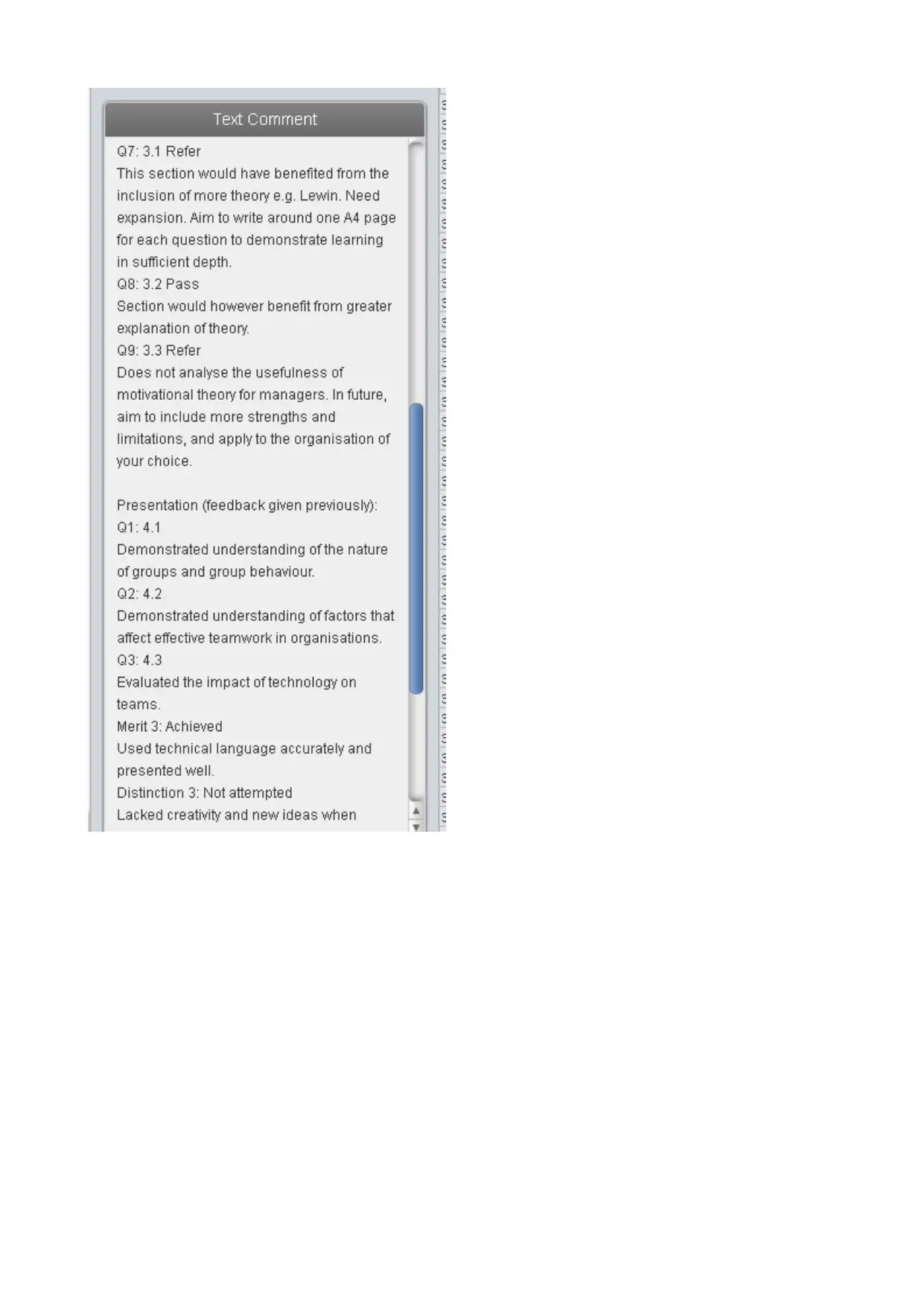
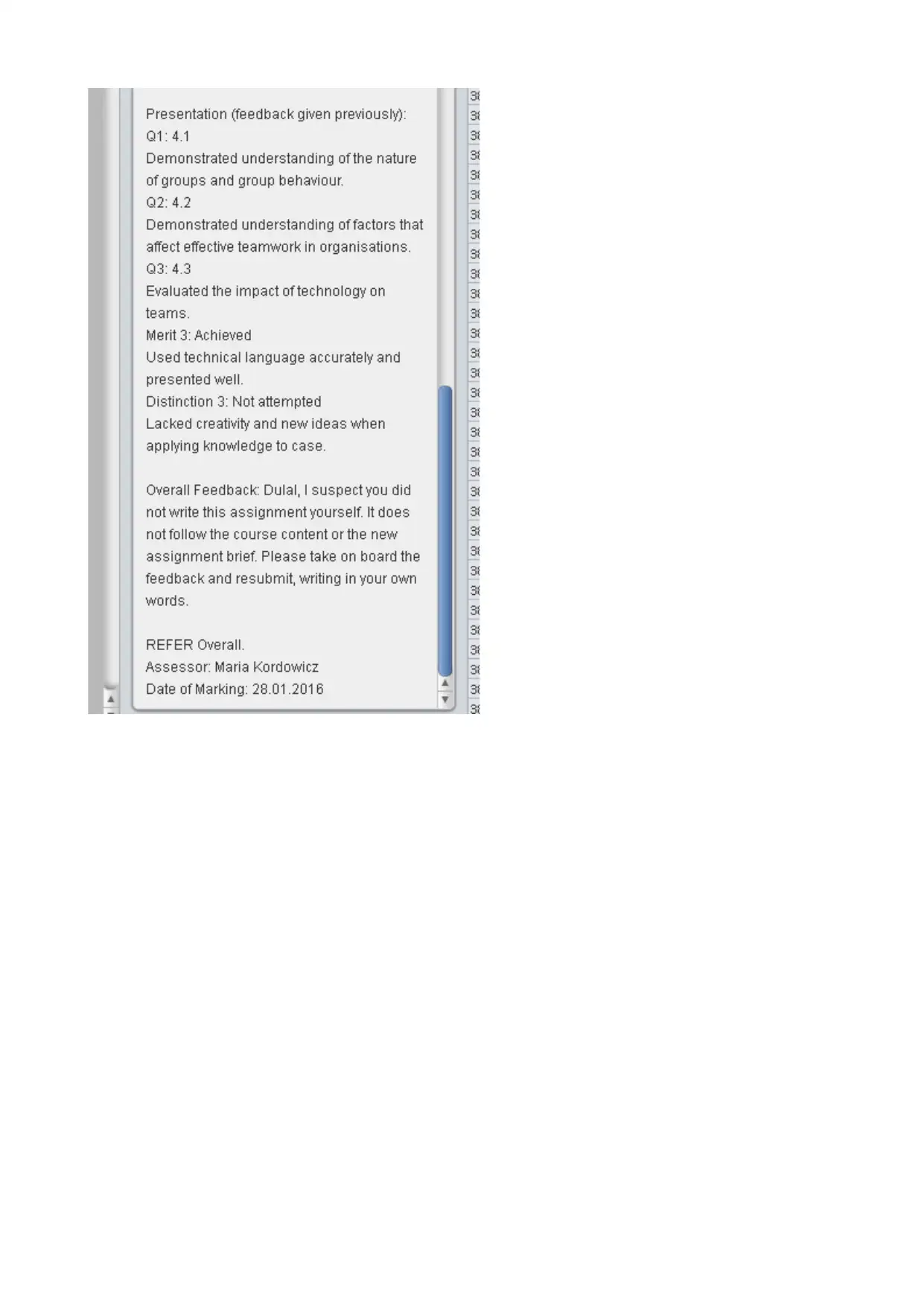
⊘ This is a preview!⊘
Do you want full access?
Subscribe today to unlock all pages.

Trusted by 1+ million students worldwide

Paraphrase This Document
Need a fresh take? Get an instant paraphrase of this document with our AI Paraphraser

TABLE OF CONTENTS
INTRODUCTION................................................................................................................................6
TASK 1.................................................................................................................................................6
1.1................................................................................................................................................6
1.2)..............................................................................................................................................7
Merit 1.........................................................................................................................................7
D2................................................................................................................................................7
1.3)..............................................................................................................................................7
2.2)..............................................................................................................................................8
Merit 2.........................................................................................................................................9
2.3 The contribution to management is as follows-....................................................................9
2.1)............................................................................................................................................10
F)...............................................................................................................................................10
3.1)............................................................................................................................................10
3.2)............................................................................................................................................11
3.3)............................................................................................................................................11
CONCLUSION...................................................................................................................................11
REFERENCES...................................................................................................................................12
INTRODUCTION................................................................................................................................6
TASK 1.................................................................................................................................................6
1.1................................................................................................................................................6
1.2)..............................................................................................................................................7
Merit 1.........................................................................................................................................7
D2................................................................................................................................................7
1.3)..............................................................................................................................................7
2.2)..............................................................................................................................................8
Merit 2.........................................................................................................................................9
2.3 The contribution to management is as follows-....................................................................9
2.1)............................................................................................................................................10
F)...............................................................................................................................................10
3.1)............................................................................................................................................10
3.2)............................................................................................................................................11
3.3)............................................................................................................................................11
CONCLUSION...................................................................................................................................11
REFERENCES...................................................................................................................................12
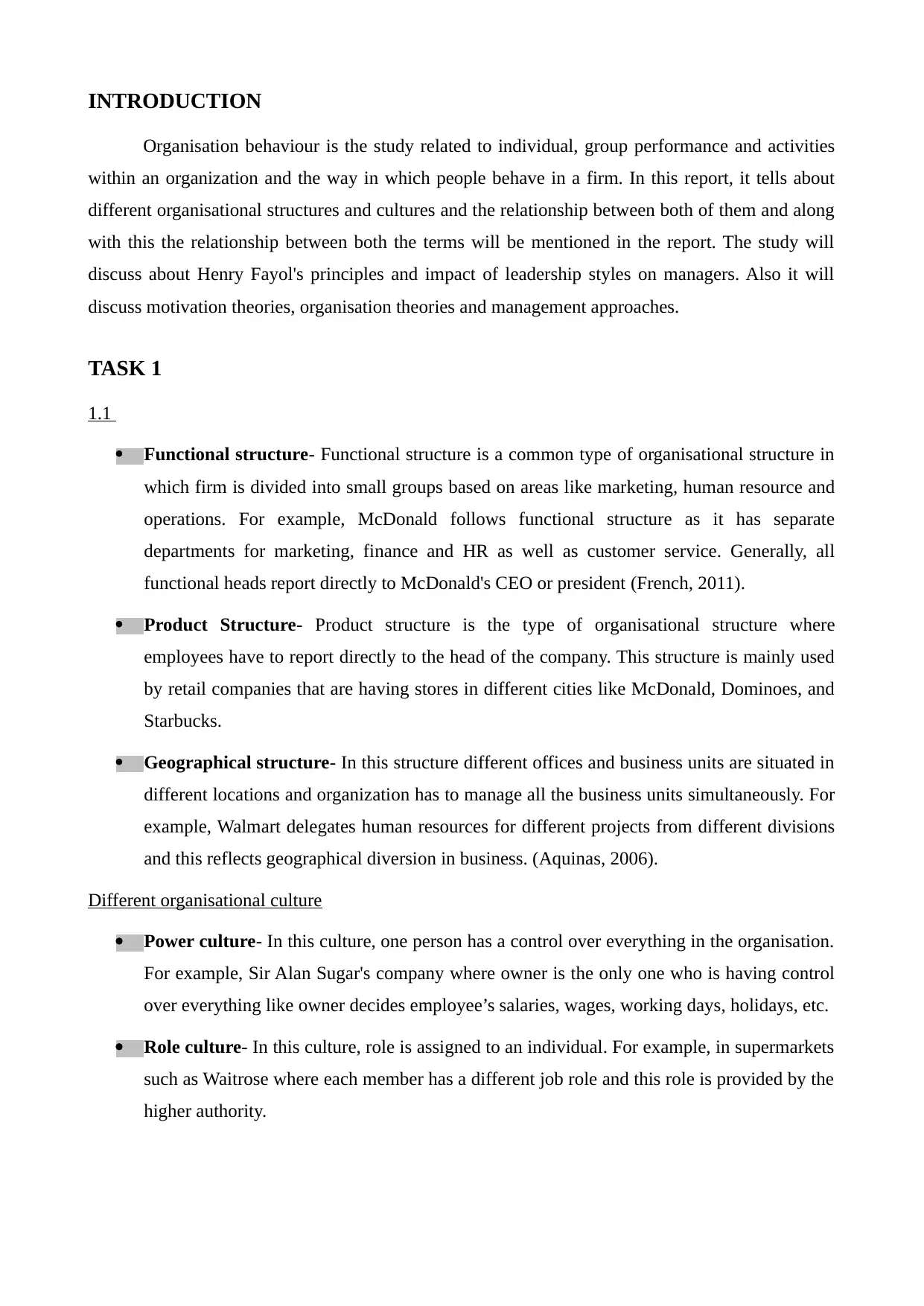
INTRODUCTION
Organisation behaviour is the study related to individual, group performance and activities
within an organization and the way in which people behave in a firm. In this report, it tells about
different organisational structures and cultures and the relationship between both of them and along
with this the relationship between both the terms will be mentioned in the report. The study will
discuss about Henry Fayol's principles and impact of leadership styles on managers. Also it will
discuss motivation theories, organisation theories and management approaches.
TASK 1
1.1
Functional structure- Functional structure is a common type of organisational structure in
which firm is divided into small groups based on areas like marketing, human resource and
operations. For example, McDonald follows functional structure as it has separate
departments for marketing, finance and HR as well as customer service. Generally, all
functional heads report directly to McDonald's CEO or president (French, 2011).
Product Structure- Product structure is the type of organisational structure where
employees have to report directly to the head of the company. This structure is mainly used
by retail companies that are having stores in different cities like McDonald, Dominoes, and
Starbucks.
Geographical structure- In this structure different offices and business units are situated in
different locations and organization has to manage all the business units simultaneously. For
example, Walmart delegates human resources for different projects from different divisions
and this reflects geographical diversion in business. (Aquinas, 2006).
Different organisational culture
Power culture- In this culture, one person has a control over everything in the organisation.
For example, Sir Alan Sugar's company where owner is the only one who is having control
over everything like owner decides employee’s salaries, wages, working days, holidays, etc.
Role culture- In this culture, role is assigned to an individual. For example, in supermarkets
such as Waitrose where each member has a different job role and this role is provided by the
higher authority.
Organisation behaviour is the study related to individual, group performance and activities
within an organization and the way in which people behave in a firm. In this report, it tells about
different organisational structures and cultures and the relationship between both of them and along
with this the relationship between both the terms will be mentioned in the report. The study will
discuss about Henry Fayol's principles and impact of leadership styles on managers. Also it will
discuss motivation theories, organisation theories and management approaches.
TASK 1
1.1
Functional structure- Functional structure is a common type of organisational structure in
which firm is divided into small groups based on areas like marketing, human resource and
operations. For example, McDonald follows functional structure as it has separate
departments for marketing, finance and HR as well as customer service. Generally, all
functional heads report directly to McDonald's CEO or president (French, 2011).
Product Structure- Product structure is the type of organisational structure where
employees have to report directly to the head of the company. This structure is mainly used
by retail companies that are having stores in different cities like McDonald, Dominoes, and
Starbucks.
Geographical structure- In this structure different offices and business units are situated in
different locations and organization has to manage all the business units simultaneously. For
example, Walmart delegates human resources for different projects from different divisions
and this reflects geographical diversion in business. (Aquinas, 2006).
Different organisational culture
Power culture- In this culture, one person has a control over everything in the organisation.
For example, Sir Alan Sugar's company where owner is the only one who is having control
over everything like owner decides employee’s salaries, wages, working days, holidays, etc.
Role culture- In this culture, role is assigned to an individual. For example, in supermarkets
such as Waitrose where each member has a different job role and this role is provided by the
higher authority.
⊘ This is a preview!⊘
Do you want full access?
Subscribe today to unlock all pages.

Trusted by 1+ million students worldwide
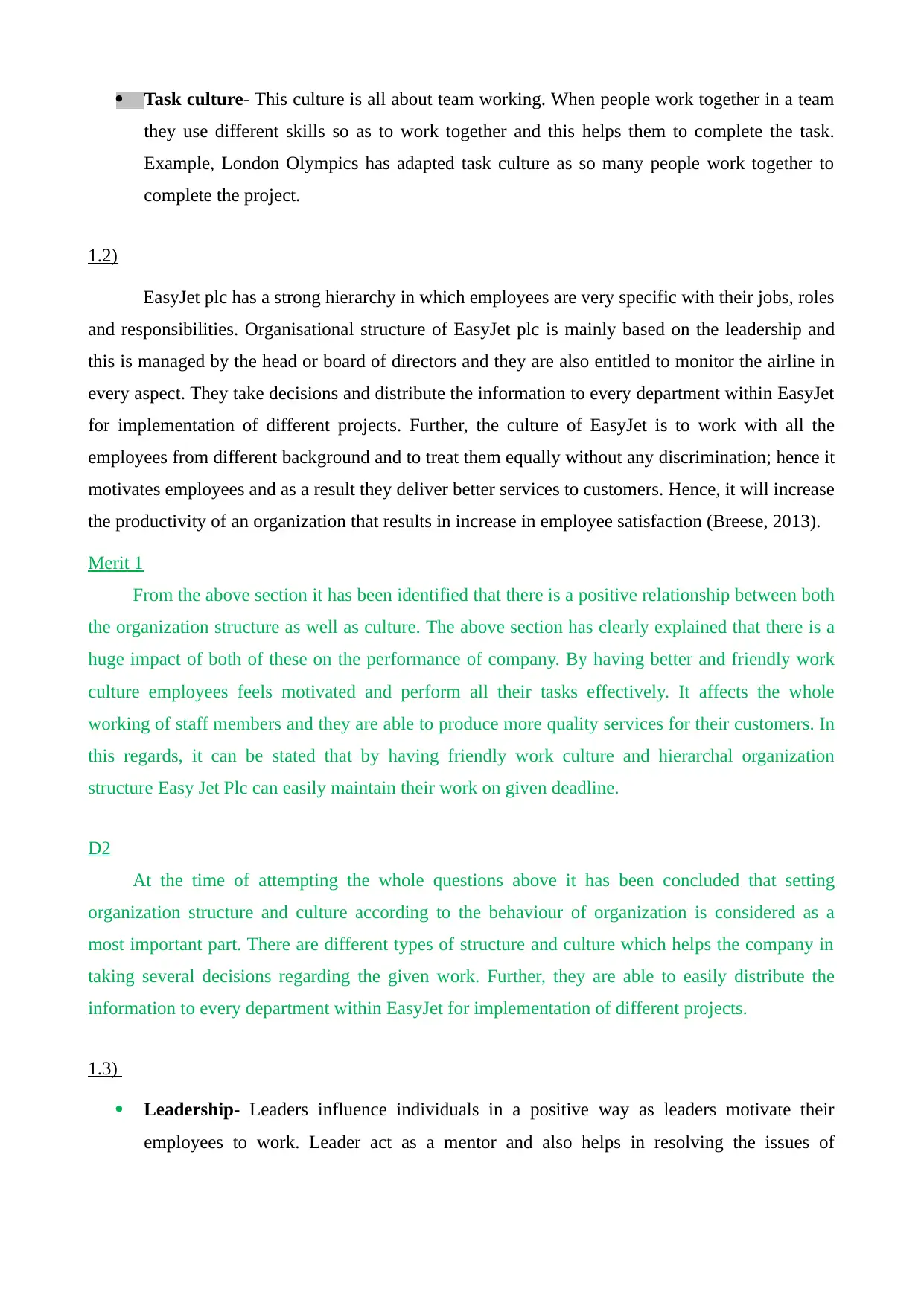
Task culture- This culture is all about team working. When people work together in a team
they use different skills so as to work together and this helps them to complete the task.
Example, London Olympics has adapted task culture as so many people work together to
complete the project.
1.2)
EasyJet plc has a strong hierarchy in which employees are very specific with their jobs, roles
and responsibilities. Organisational structure of EasyJet plc is mainly based on the leadership and
this is managed by the head or board of directors and they are also entitled to monitor the airline in
every aspect. They take decisions and distribute the information to every department within EasyJet
for implementation of different projects. Further, the culture of EasyJet is to work with all the
employees from different background and to treat them equally without any discrimination; hence it
motivates employees and as a result they deliver better services to customers. Hence, it will increase
the productivity of an organization that results in increase in employee satisfaction (Breese, 2013).
Merit 1
From the above section it has been identified that there is a positive relationship between both
the organization structure as well as culture. The above section has clearly explained that there is a
huge impact of both of these on the performance of company. By having better and friendly work
culture employees feels motivated and perform all their tasks effectively. It affects the whole
working of staff members and they are able to produce more quality services for their customers. In
this regards, it can be stated that by having friendly work culture and hierarchal organization
structure Easy Jet Plc can easily maintain their work on given deadline.
D2
At the time of attempting the whole questions above it has been concluded that setting
organization structure and culture according to the behaviour of organization is considered as a
most important part. There are different types of structure and culture which helps the company in
taking several decisions regarding the given work. Further, they are able to easily distribute the
information to every department within EasyJet for implementation of different projects.
1.3)
Leadership- Leaders influence individuals in a positive way as leaders motivate their
employees to work. Leader act as a mentor and also helps in resolving the issues of
they use different skills so as to work together and this helps them to complete the task.
Example, London Olympics has adapted task culture as so many people work together to
complete the project.
1.2)
EasyJet plc has a strong hierarchy in which employees are very specific with their jobs, roles
and responsibilities. Organisational structure of EasyJet plc is mainly based on the leadership and
this is managed by the head or board of directors and they are also entitled to monitor the airline in
every aspect. They take decisions and distribute the information to every department within EasyJet
for implementation of different projects. Further, the culture of EasyJet is to work with all the
employees from different background and to treat them equally without any discrimination; hence it
motivates employees and as a result they deliver better services to customers. Hence, it will increase
the productivity of an organization that results in increase in employee satisfaction (Breese, 2013).
Merit 1
From the above section it has been identified that there is a positive relationship between both
the organization structure as well as culture. The above section has clearly explained that there is a
huge impact of both of these on the performance of company. By having better and friendly work
culture employees feels motivated and perform all their tasks effectively. It affects the whole
working of staff members and they are able to produce more quality services for their customers. In
this regards, it can be stated that by having friendly work culture and hierarchal organization
structure Easy Jet Plc can easily maintain their work on given deadline.
D2
At the time of attempting the whole questions above it has been concluded that setting
organization structure and culture according to the behaviour of organization is considered as a
most important part. There are different types of structure and culture which helps the company in
taking several decisions regarding the given work. Further, they are able to easily distribute the
information to every department within EasyJet for implementation of different projects.
1.3)
Leadership- Leaders influence individuals in a positive way as leaders motivate their
employees to work. Leader act as a mentor and also helps in resolving the issues of
Paraphrase This Document
Need a fresh take? Get an instant paraphrase of this document with our AI Paraphraser
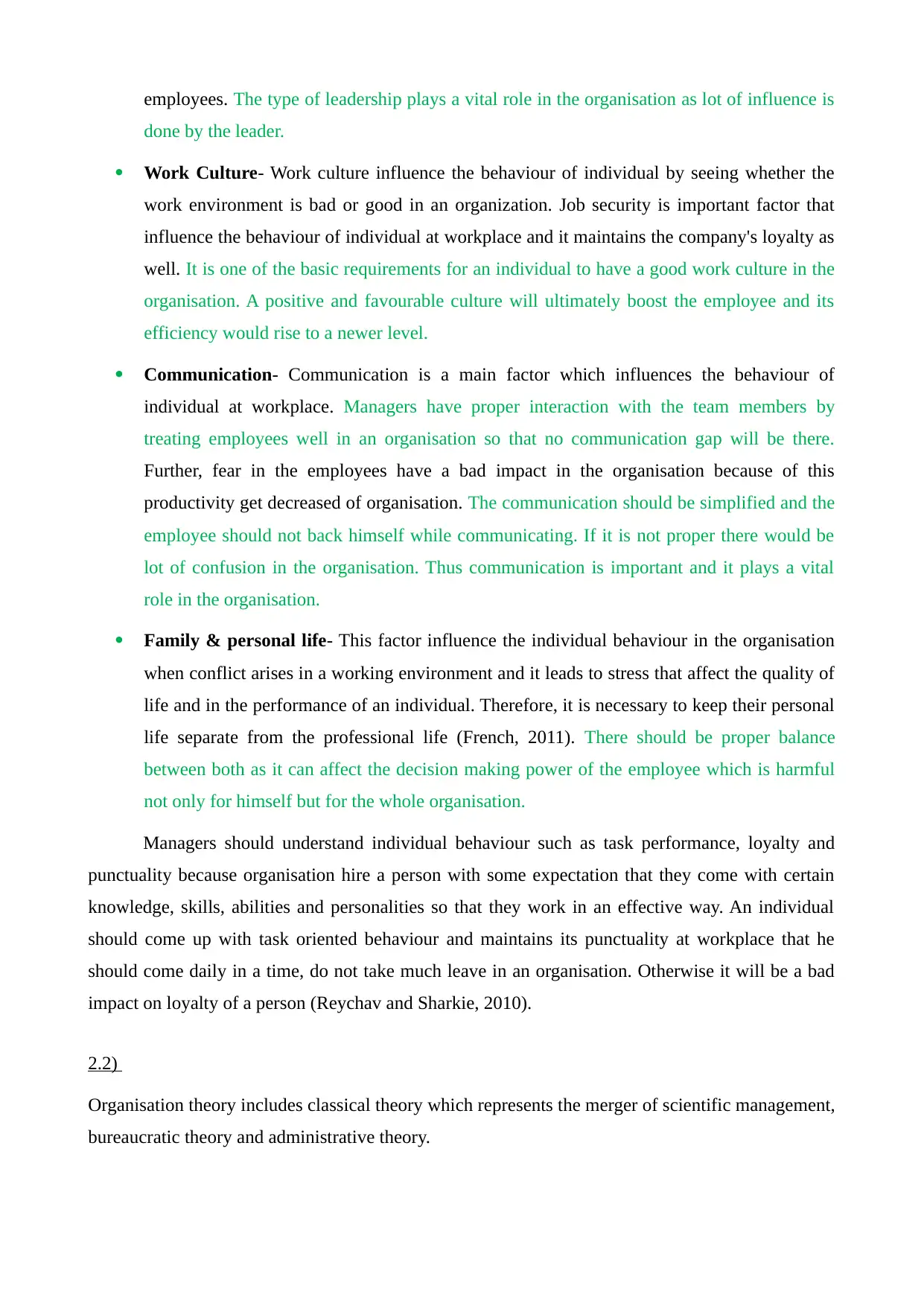
employees. The type of leadership plays a vital role in the organisation as lot of influence is
done by the leader.
Work Culture- Work culture influence the behaviour of individual by seeing whether the
work environment is bad or good in an organization. Job security is important factor that
influence the behaviour of individual at workplace and it maintains the company's loyalty as
well. It is one of the basic requirements for an individual to have a good work culture in the
organisation. A positive and favourable culture will ultimately boost the employee and its
efficiency would rise to a newer level.
Communication- Communication is a main factor which influences the behaviour of
individual at workplace. Managers have proper interaction with the team members by
treating employees well in an organisation so that no communication gap will be there.
Further, fear in the employees have a bad impact in the organisation because of this
productivity get decreased of organisation. The communication should be simplified and the
employee should not back himself while communicating. If it is not proper there would be
lot of confusion in the organisation. Thus communication is important and it plays a vital
role in the organisation.
Family & personal life- This factor influence the individual behaviour in the organisation
when conflict arises in a working environment and it leads to stress that affect the quality of
life and in the performance of an individual. Therefore, it is necessary to keep their personal
life separate from the professional life (French, 2011). There should be proper balance
between both as it can affect the decision making power of the employee which is harmful
not only for himself but for the whole organisation.
Managers should understand individual behaviour such as task performance, loyalty and
punctuality because organisation hire a person with some expectation that they come with certain
knowledge, skills, abilities and personalities so that they work in an effective way. An individual
should come up with task oriented behaviour and maintains its punctuality at workplace that he
should come daily in a time, do not take much leave in an organisation. Otherwise it will be a bad
impact on loyalty of a person (Reychav and Sharkie, 2010).
2.2)
Organisation theory includes classical theory which represents the merger of scientific management,
bureaucratic theory and administrative theory.
done by the leader.
Work Culture- Work culture influence the behaviour of individual by seeing whether the
work environment is bad or good in an organization. Job security is important factor that
influence the behaviour of individual at workplace and it maintains the company's loyalty as
well. It is one of the basic requirements for an individual to have a good work culture in the
organisation. A positive and favourable culture will ultimately boost the employee and its
efficiency would rise to a newer level.
Communication- Communication is a main factor which influences the behaviour of
individual at workplace. Managers have proper interaction with the team members by
treating employees well in an organisation so that no communication gap will be there.
Further, fear in the employees have a bad impact in the organisation because of this
productivity get decreased of organisation. The communication should be simplified and the
employee should not back himself while communicating. If it is not proper there would be
lot of confusion in the organisation. Thus communication is important and it plays a vital
role in the organisation.
Family & personal life- This factor influence the individual behaviour in the organisation
when conflict arises in a working environment and it leads to stress that affect the quality of
life and in the performance of an individual. Therefore, it is necessary to keep their personal
life separate from the professional life (French, 2011). There should be proper balance
between both as it can affect the decision making power of the employee which is harmful
not only for himself but for the whole organisation.
Managers should understand individual behaviour such as task performance, loyalty and
punctuality because organisation hire a person with some expectation that they come with certain
knowledge, skills, abilities and personalities so that they work in an effective way. An individual
should come up with task oriented behaviour and maintains its punctuality at workplace that he
should come daily in a time, do not take much leave in an organisation. Otherwise it will be a bad
impact on loyalty of a person (Reychav and Sharkie, 2010).
2.2)
Organisation theory includes classical theory which represents the merger of scientific management,
bureaucratic theory and administrative theory.
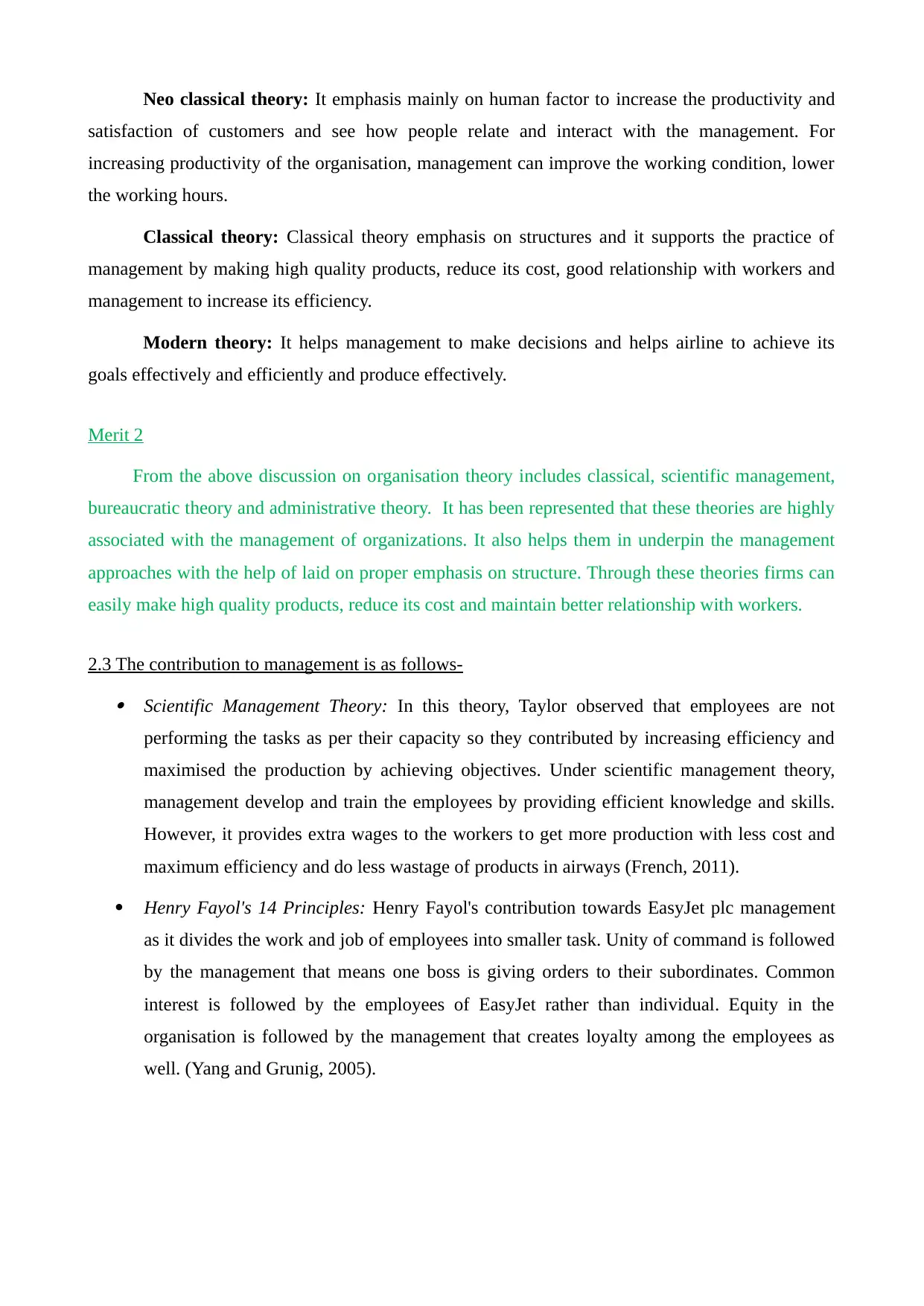
Neo classical theory: It emphasis mainly on human factor to increase the productivity and
satisfaction of customers and see how people relate and interact with the management. For
increasing productivity of the organisation, management can improve the working condition, lower
the working hours.
Classical theory: Classical theory emphasis on structures and it supports the practice of
management by making high quality products, reduce its cost, good relationship with workers and
management to increase its efficiency.
Modern theory: It helps management to make decisions and helps airline to achieve its
goals effectively and efficiently and produce effectively.
Merit 2
From the above discussion on organisation theory includes classical, scientific management,
bureaucratic theory and administrative theory. It has been represented that these theories are highly
associated with the management of organizations. It also helps them in underpin the management
approaches with the help of laid on proper emphasis on structure. Through these theories firms can
easily make high quality products, reduce its cost and maintain better relationship with workers.
2.3 The contribution to management is as follows-
Scientific Management Theory: In this theory, Taylor observed that employees are not
performing the tasks as per their capacity so they contributed by increasing efficiency and
maximised the production by achieving objectives. Under scientific management theory,
management develop and train the employees by providing efficient knowledge and skills.
However, it provides extra wages to the workers to get more production with less cost and
maximum efficiency and do less wastage of products in airways (French, 2011).
Henry Fayol's 14 Principles: Henry Fayol's contribution towards EasyJet plc management
as it divides the work and job of employees into smaller task. Unity of command is followed
by the management that means one boss is giving orders to their subordinates. Common
interest is followed by the employees of EasyJet rather than individual. Equity in the
organisation is followed by the management that creates loyalty among the employees as
well. (Yang and Grunig, 2005).
satisfaction of customers and see how people relate and interact with the management. For
increasing productivity of the organisation, management can improve the working condition, lower
the working hours.
Classical theory: Classical theory emphasis on structures and it supports the practice of
management by making high quality products, reduce its cost, good relationship with workers and
management to increase its efficiency.
Modern theory: It helps management to make decisions and helps airline to achieve its
goals effectively and efficiently and produce effectively.
Merit 2
From the above discussion on organisation theory includes classical, scientific management,
bureaucratic theory and administrative theory. It has been represented that these theories are highly
associated with the management of organizations. It also helps them in underpin the management
approaches with the help of laid on proper emphasis on structure. Through these theories firms can
easily make high quality products, reduce its cost and maintain better relationship with workers.
2.3 The contribution to management is as follows-
Scientific Management Theory: In this theory, Taylor observed that employees are not
performing the tasks as per their capacity so they contributed by increasing efficiency and
maximised the production by achieving objectives. Under scientific management theory,
management develop and train the employees by providing efficient knowledge and skills.
However, it provides extra wages to the workers to get more production with less cost and
maximum efficiency and do less wastage of products in airways (French, 2011).
Henry Fayol's 14 Principles: Henry Fayol's contribution towards EasyJet plc management
as it divides the work and job of employees into smaller task. Unity of command is followed
by the management that means one boss is giving orders to their subordinates. Common
interest is followed by the employees of EasyJet rather than individual. Equity in the
organisation is followed by the management that creates loyalty among the employees as
well. (Yang and Grunig, 2005).
⊘ This is a preview!⊘
Do you want full access?
Subscribe today to unlock all pages.

Trusted by 1+ million students worldwide

2.1)
Leadership means ability to make decisions and inspire people in an organisation.
Leadership styles followed by the Easy Jet and British airways are democratic and transformational
style. British airways follow democratic style wherein the leaders make decisions and also take
suggestions from the employees. This style of leadership is also called participative style of
leadership. However, on the other hand EasyJet follows transformational style of leadership in
which leaders enhance the employees’ efficiency by motivating and inspire them. Hence, both
British airways and EasyJet have effective style of leadership but British airways has more effective
leadership as it takes suggestions from employees and make decisions by keeping in mind the
suggestions of employees.
F)
The two different approaches in organisational behaviour are Human Resource Approach
and System Approach. British airways use human resource approach in which it focuses on the
growth and development of employees. It helps employees in performing better work so that their
abilities can get enhanced and this in turn can result in good performance. EasyJet use system
approach in which the top authority has a power to manage the whole system of the organization. It
has a system with parts such as employees, resources, products which form a combine system. Top
managers take all the decisions and this helps in building managers in an effective manner which
also increases organisational productivity. Hence, the overall effort maximises the profit
(Warmerdam and et. al., 2015).
3.1)
The effect of leadership styles on motivation of managers and staffs performance in British
airways and EasyJet plc are as follows during the change:
Participative leadership style: This type of leadership style helps in boosting the morale of
employees during the change as they accept the change. When Easy Jet follows participative
leadership style, employees are given an opportunity to take part in the decision making while the
final decision making rests with the leader. The employees feel more involved as they make
contribution in decision making process.
Transformational leadership style: In this type of leadership the leader gets the goal and
delegates smaller tasks to the team. The employees have a certain goal and they are also involved in
the task. So they become more acceptable to the change.
Leadership means ability to make decisions and inspire people in an organisation.
Leadership styles followed by the Easy Jet and British airways are democratic and transformational
style. British airways follow democratic style wherein the leaders make decisions and also take
suggestions from the employees. This style of leadership is also called participative style of
leadership. However, on the other hand EasyJet follows transformational style of leadership in
which leaders enhance the employees’ efficiency by motivating and inspire them. Hence, both
British airways and EasyJet have effective style of leadership but British airways has more effective
leadership as it takes suggestions from employees and make decisions by keeping in mind the
suggestions of employees.
F)
The two different approaches in organisational behaviour are Human Resource Approach
and System Approach. British airways use human resource approach in which it focuses on the
growth and development of employees. It helps employees in performing better work so that their
abilities can get enhanced and this in turn can result in good performance. EasyJet use system
approach in which the top authority has a power to manage the whole system of the organization. It
has a system with parts such as employees, resources, products which form a combine system. Top
managers take all the decisions and this helps in building managers in an effective manner which
also increases organisational productivity. Hence, the overall effort maximises the profit
(Warmerdam and et. al., 2015).
3.1)
The effect of leadership styles on motivation of managers and staffs performance in British
airways and EasyJet plc are as follows during the change:
Participative leadership style: This type of leadership style helps in boosting the morale of
employees during the change as they accept the change. When Easy Jet follows participative
leadership style, employees are given an opportunity to take part in the decision making while the
final decision making rests with the leader. The employees feel more involved as they make
contribution in decision making process.
Transformational leadership style: In this type of leadership the leader gets the goal and
delegates smaller tasks to the team. The employees have a certain goal and they are also involved in
the task. So they become more acceptable to the change.
Paraphrase This Document
Need a fresh take? Get an instant paraphrase of this document with our AI Paraphraser
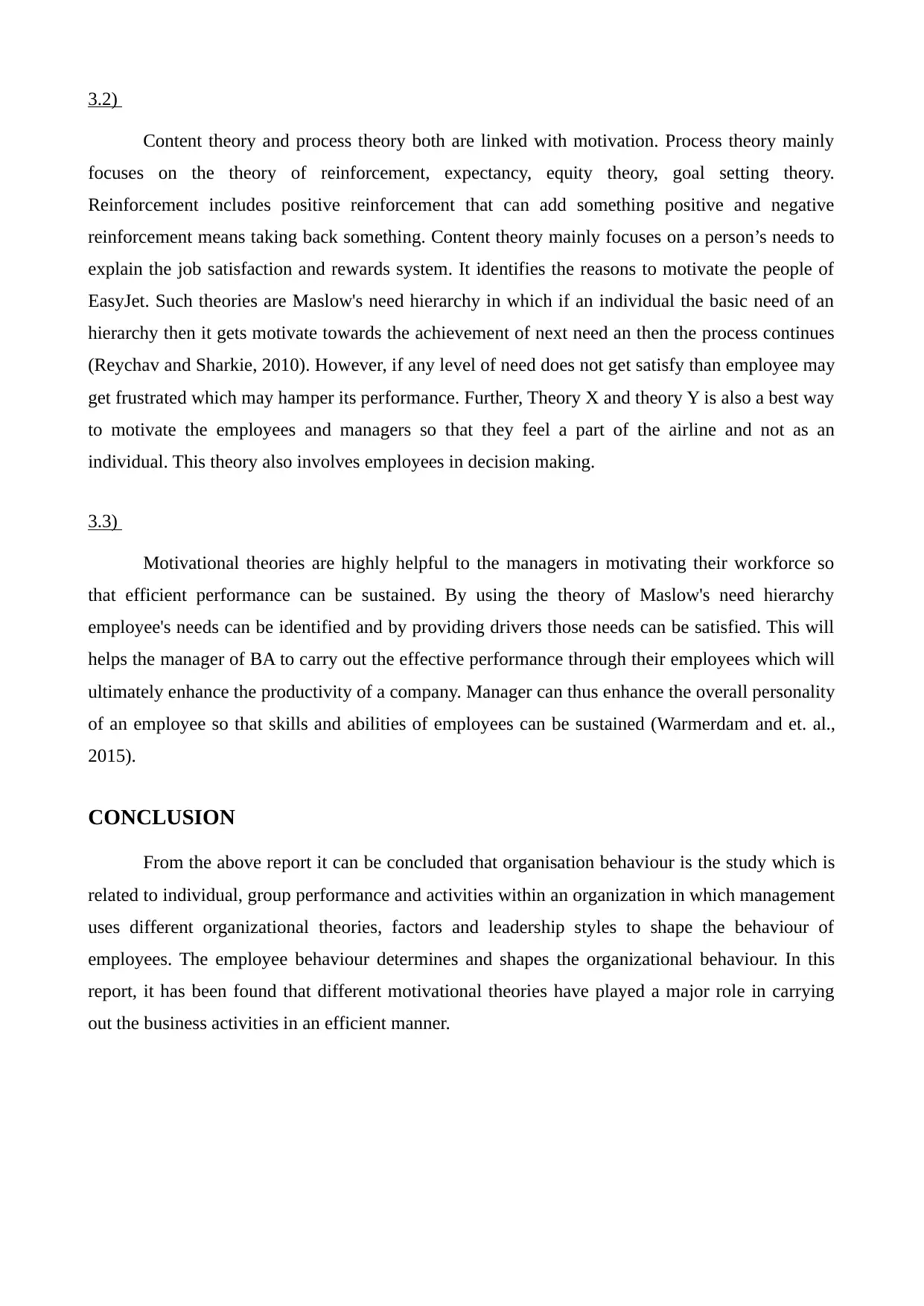
3.2)
Content theory and process theory both are linked with motivation. Process theory mainly
focuses on the theory of reinforcement, expectancy, equity theory, goal setting theory.
Reinforcement includes positive reinforcement that can add something positive and negative
reinforcement means taking back something. Content theory mainly focuses on a person’s needs to
explain the job satisfaction and rewards system. It identifies the reasons to motivate the people of
EasyJet. Such theories are Maslow's need hierarchy in which if an individual the basic need of an
hierarchy then it gets motivate towards the achievement of next need an then the process continues
(Reychav and Sharkie, 2010). However, if any level of need does not get satisfy than employee may
get frustrated which may hamper its performance. Further, Theory X and theory Y is also a best way
to motivate the employees and managers so that they feel a part of the airline and not as an
individual. This theory also involves employees in decision making.
3.3)
Motivational theories are highly helpful to the managers in motivating their workforce so
that efficient performance can be sustained. By using the theory of Maslow's need hierarchy
employee's needs can be identified and by providing drivers those needs can be satisfied. This will
helps the manager of BA to carry out the effective performance through their employees which will
ultimately enhance the productivity of a company. Manager can thus enhance the overall personality
of an employee so that skills and abilities of employees can be sustained (Warmerdam and et. al.,
2015).
CONCLUSION
From the above report it can be concluded that organisation behaviour is the study which is
related to individual, group performance and activities within an organization in which management
uses different organizational theories, factors and leadership styles to shape the behaviour of
employees. The employee behaviour determines and shapes the organizational behaviour. In this
report, it has been found that different motivational theories have played a major role in carrying
out the business activities in an efficient manner.
Content theory and process theory both are linked with motivation. Process theory mainly
focuses on the theory of reinforcement, expectancy, equity theory, goal setting theory.
Reinforcement includes positive reinforcement that can add something positive and negative
reinforcement means taking back something. Content theory mainly focuses on a person’s needs to
explain the job satisfaction and rewards system. It identifies the reasons to motivate the people of
EasyJet. Such theories are Maslow's need hierarchy in which if an individual the basic need of an
hierarchy then it gets motivate towards the achievement of next need an then the process continues
(Reychav and Sharkie, 2010). However, if any level of need does not get satisfy than employee may
get frustrated which may hamper its performance. Further, Theory X and theory Y is also a best way
to motivate the employees and managers so that they feel a part of the airline and not as an
individual. This theory also involves employees in decision making.
3.3)
Motivational theories are highly helpful to the managers in motivating their workforce so
that efficient performance can be sustained. By using the theory of Maslow's need hierarchy
employee's needs can be identified and by providing drivers those needs can be satisfied. This will
helps the manager of BA to carry out the effective performance through their employees which will
ultimately enhance the productivity of a company. Manager can thus enhance the overall personality
of an employee so that skills and abilities of employees can be sustained (Warmerdam and et. al.,
2015).
CONCLUSION
From the above report it can be concluded that organisation behaviour is the study which is
related to individual, group performance and activities within an organization in which management
uses different organizational theories, factors and leadership styles to shape the behaviour of
employees. The employee behaviour determines and shapes the organizational behaviour. In this
report, it has been found that different motivational theories have played a major role in carrying
out the business activities in an efficient manner.

REFERENCES
Journals
Breese, R., 2013. Conceptualising the nature of work: revisiting Luther Gulick's theories of
organisation. Journal of Management History. 19(2). pp.279-294.
Chen, N. Y. and Ke, R. H., 2013. An analysis of users' behaviour patterns in the organisation of
information: A case study of CiteULike. Online Information Review. 37(4). pp.638-656.
Espejo, R., 2015. The cybernetics of self-organisation. Kybernetes. 44(6/7).
Mutshewa, A., 2007. A theoretical exploration of information behaviour: a power perspective. Aslib
Proceedings. 59(3). pp.249-263.
Reychav, I. and Sharkie, R., 2010. Trust: an antecedent to employee extra‐role behaviour. Journal
of Intellectual Capital. 11(2). pp.227-247.
Reychav, I. and Sharkie, R., 2010. Trust: an antecedent to employee extra‐role behaviour. Journal
of Intellectual Capital. 11(2). pp.227-247.
Sanders, K. and Schyns, B., 2006. Leadership and solidarity behaviour: Consensus in perception of
employees within teams. Personnel Review. 35(5). pp.538-556.
Schoemaker, M. and Jonker, J., 2005. Managing intangible assets: An essay on organising
contemporary organisations based upon identity, competencies and networks. Journal of
Management Development. 24(6). pp.506-518.
Slaunwhite, M. J. and et. al., 2009. Using normative messages to increase healthy behaviours.
International Journal of Workplace Health Management. 2(3). pp.231-244.
Tupman, B., 2015. What does the way crime was organised yesterday tell us about the way crime is
organised today and will be tomorrow. Journal of Money Laundering Control. 18(2).
pp.220-233.
Warmerdam, A. and et. al., 2015. Gen Y recruitment: Understanding graduate intentions to join an
organisation using the Theory of Planned Behaviour. Education + Training. 57(5). pp.560-
574.
Yang, U. S. and Grunig, E. J., 2005. Decomposing organisational reputation: The effects of
organisation–public relationship outcomes on cognitive representations of organisations
and evaluations of organisational performance. Journal of Communication Management.
Journals
Breese, R., 2013. Conceptualising the nature of work: revisiting Luther Gulick's theories of
organisation. Journal of Management History. 19(2). pp.279-294.
Chen, N. Y. and Ke, R. H., 2013. An analysis of users' behaviour patterns in the organisation of
information: A case study of CiteULike. Online Information Review. 37(4). pp.638-656.
Espejo, R., 2015. The cybernetics of self-organisation. Kybernetes. 44(6/7).
Mutshewa, A., 2007. A theoretical exploration of information behaviour: a power perspective. Aslib
Proceedings. 59(3). pp.249-263.
Reychav, I. and Sharkie, R., 2010. Trust: an antecedent to employee extra‐role behaviour. Journal
of Intellectual Capital. 11(2). pp.227-247.
Reychav, I. and Sharkie, R., 2010. Trust: an antecedent to employee extra‐role behaviour. Journal
of Intellectual Capital. 11(2). pp.227-247.
Sanders, K. and Schyns, B., 2006. Leadership and solidarity behaviour: Consensus in perception of
employees within teams. Personnel Review. 35(5). pp.538-556.
Schoemaker, M. and Jonker, J., 2005. Managing intangible assets: An essay on organising
contemporary organisations based upon identity, competencies and networks. Journal of
Management Development. 24(6). pp.506-518.
Slaunwhite, M. J. and et. al., 2009. Using normative messages to increase healthy behaviours.
International Journal of Workplace Health Management. 2(3). pp.231-244.
Tupman, B., 2015. What does the way crime was organised yesterday tell us about the way crime is
organised today and will be tomorrow. Journal of Money Laundering Control. 18(2).
pp.220-233.
Warmerdam, A. and et. al., 2015. Gen Y recruitment: Understanding graduate intentions to join an
organisation using the Theory of Planned Behaviour. Education + Training. 57(5). pp.560-
574.
Yang, U. S. and Grunig, E. J., 2005. Decomposing organisational reputation: The effects of
organisation–public relationship outcomes on cognitive representations of organisations
and evaluations of organisational performance. Journal of Communication Management.
⊘ This is a preview!⊘
Do you want full access?
Subscribe today to unlock all pages.

Trusted by 1+ million students worldwide
1 out of 14
Related Documents
Your All-in-One AI-Powered Toolkit for Academic Success.
+13062052269
info@desklib.com
Available 24*7 on WhatsApp / Email
![[object Object]](/_next/static/media/star-bottom.7253800d.svg)
Unlock your academic potential
Copyright © 2020–2025 A2Z Services. All Rights Reserved. Developed and managed by ZUCOL.




